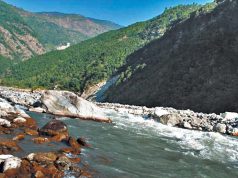London, March 8, 2016: Nepal a country which faced last year’s devastating earthquake had hundreds and thousands homeless. It turns to bamboo, nicknamed “vegetable steel†to rebuild homes and schools.
Nepalese architect Nripal Adhikary said, “Bamboo is a great material. The biggest enemy (in a quake) is weight so bamboo is perfect because it is light, flexible and very strong.â€
Furthermore he verified bamboo to be as strong as steel being much more ecological as it doesn’t need energy to produce. Due to its strength people call it ‘vegetable steel’.
Almost 9000 people were killed and over a million buildings destroyed due to the twin earthquakes in April and May 2015. Despite having donors willing to pay $4.1 billion for reconstruction rebuilding has been delayed by a political crisis.
The government had recently approved the use of bamboo to rebuild schools and was expected to approve its use for reconstructing homes, said Adhikary.
Due to its availability in mountainous terrains and being light weight just adds up to its idealness for rebuilding in Nepal’s mountainous regions, said Adhikary who is the national coordinator for the International Network for Bamboo and Rattan (INBAR) of Nepal.
Not only its strength, light weight and availability makes it a suitable resource to rebuild in Nepal but it’s also about 50 percent cheaper than with other materials.
The new systems for joining bamboo lengths including the technological advances have improved its durability as well as build larger span structures than in the past.
INBAR is working with Nepal’s government and other organizations on a $800,000 pilot project using bamboo to build 150 homes and 10 schools which they hope other agencies will replicate.
In order to discuss bamboo use in reconstruction programs the government ministers, aid agencies and building experts attended a workshop in Kathmandu last week.
Nepal is home to 54 bamboo species with coverage estimated at 63,000 hectares. Experts say its sustainable use will also help boost local employment and economies.
Interest in building with bamboo in quake-prone regions had grown since a 1999 in Colombia said earthquake engineering expert David Trujillo.
While many newer masonry buildings collapsed, the older bamboo buildings withstood the tremor. Afterwards there was a big effort to rebuild with bamboo.
According to him bamboo was a very sustainable material which grew extremely fast, reaching 25 to 30 meters only in six months.
Compared to a tree which might need 30 to 50 years to harvest bamboo can be harvested only within 3-5 years, said Trujillo, now a lecturer at Britain’s Coventry University.
Among the countries, along with Nepal are Ecuador, Peru, Philippines and Mexico who have studied Colombia’s experience in using bamboo in quake-prone locations.







